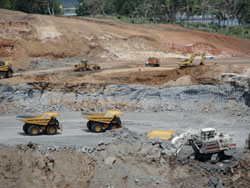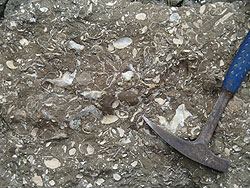Research in Invertebrates
Our research is focused on gathering biostratigraphic, paleoenvironmental, and biogeographic data that can be used to support investigations into the geologic evolution of the Panama region. Most of the effort has been applied towards studying the molluscan faunas of lithostratigraphic units in the Panama Canal area, which span the Eocene through Holocene. We are also studying key successions in neighboring sedimentary basins in Los Santos and Darien provinces. Our field techniques typically involve making collections with high stratigraphic resolution and taking bulk samples where feasible. We follow strict protocol in collecting accurate geographic (GPS recorded) and stratigraphic data (sections measured where possible) during specimen collection.


Specific projects in future will seek to describe:
- The invertebrate paleontology of Late Miocene facies in Lago Bayano. These rocks are correlative with the Gatun (Colon Province) and Chucunaque (Darien Province) Formations and therefore provide opportunities for comparative investigation of biodiversity, paleoecology, and taphonomy. Paleoenvironmental analysis and improved geochronology will support research on the rich associated vertebrate fauna.
- Stratigraphic as well as geographic variations in paleoenvironments and biofacies of the Gatun Formation (Late Miocene). This project incorporates new collections from the Panama Canal expansion, accessible outcrops in the vicinity of Colon, and extensive drill core material made available by the Autoridad del Canal de Panama.
- Molluscs and paleoenvironments in Eocene-Oligocene sedimentary basins of Panama, including unnamed facies in eastern Panama, the Gatuncillo Formation in the Canal Zone, and Tonosí Formation in Los Santos Province. These faunas provide not only a glimpse into diversity in the neotropics during the Paleogene, but also offer significant information concerning the evolving tectonic setting of that time.
Primary Research Contacts
Dr. Douglas S. Jones | PI
Florida Museum of Natural History